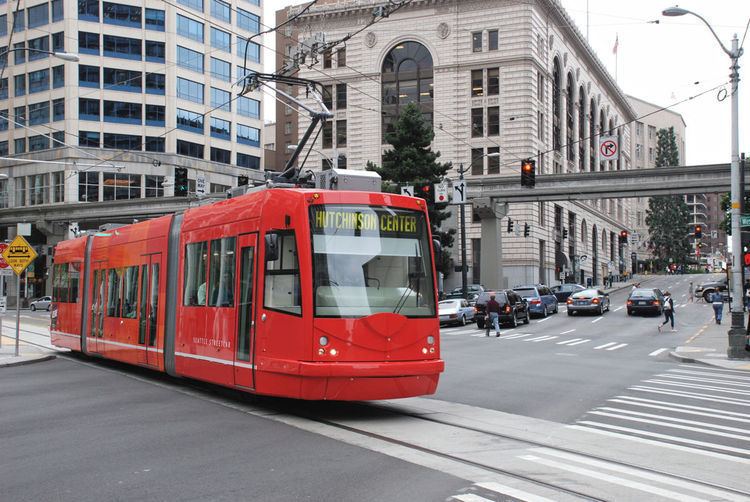Type Streetcar Stations 11 Ridership 518,300 (annual, 2016) | Status Operational Daily ridership 1,900 (December 2016) | |
 | ||
Termini South Lake Union
Westlake Center, Downtown Seattle | ||
The Seattle Streetcar—South Lake Union Line is a 1.3-mile (2.1 km) streetcar line, covering a total 2.6-mile (4.2 km) route, connecting the South Lake Union neighborhood to Downtown Seattle, Washington. Service began on December 12, 2007. It is one of two lines in the developing Seattle Streetcar system. The line was built by the Seattle Department of Transportation and is owned by the City of Seattle, but the line is operated and maintained under contract by King County Metro.
Contents
The line is popularly known by its nickname, the South Lake Union Trolley (abbreviated as "SLUT"), which is used on unofficial merchandise sold by South Lake Union businesses.
History
The Seattle Electric Railway and Power Company laid streetcar tracks on Westlake Avenue, along which the present service primarily runs, in 1890. In April 1941, the Seattle Municipal Street Railway converted its last two streetcar routes - 19 Eighth Avenue Northwest and 21 Phinney Avenue - to buses (now numbered 28 and 5, respectively); both used Westlake Avenue to reach the Fremont Bridge from downtown.
Restoration of rail service on Westlake Avenue was originally envisioned by Microsoft co-founder Paul Allen to help improve the South Lake Union neighborhood, in which his venture capital company, Vulcan Inc., is heavily invested. Allen's main supporter from the beginning was Seattle Mayor Greg Nickels, but he was not universally supported by the Seattle City Council, which was concerned about the lack of public support for the line and questioned if it should be moved ahead of Seattle's other transportation needs.
After heavy lobbying by South Lake Union businesses, including Vulcan, the Seattle City Council approved the development of the neighborhood into a biotechnology and bio-medical research center. Included in that plan was funding to investigate a 1.3-mile (2.1 km), US$45 million streetcar line. The line was approved in 2005 at a cost of $50.5 million, with $25 million paid by property owners along the streetcar's route and the remainder paid by federal, state, and local funds. The final cost was $56.4 million; additional costs were mostly utility work needed after the line opened.
The majority of property owners along the alignment supported the project, despite being asked to pay increased taxes to fund its construction. Only 12 of 750 affected property owners formally objected to the proposed "Local Improvement District" tax. The project was modeled after the Portland Streetcar, a similar modern-streetcar system that had opened in Portland, Oregon, in 2001.
The city council gave final approval to the project in March 2006, and construction began in July 2006.
Some local residents and business owners opposed to the streetcar claimed that it was originally called the South Lake Union Trolley, which abbreviates to S.L.U.T. While there is no evidence that this name was ever used as an official name, the acronym's popularity has caused it to become an unofficial one.
Service was inaugurated on December 12, 2007, and until the end of the month, all rides were free. Streetcars run every fifteen minutes, seven days a week. The line uses three 2007-built Inekon 12-Trio three-section articulated streetcars: one red, one orange and one purple, internally numbered 301, 302 and 303, respectively.
In 2009, election candidates in local Seattle politics, including almost all for city council and both candidates for mayor, said the streetcar was a bad idea.
In May 2011, increasing ridership led the Fred Hutchinson Cancer Research Center, Group Health Cooperative, UW Medicine and Amazon.com to underwrite a third streetcar to operate during peak commuting evening hours (4pm – 6pm), reducing headways from 15 minutes to 10.
In late 2012, as mitigation for its new high-rise campus in the Denny Triangle area, Amazon agreed to fund further improvements on the line. The internet retailer purchased a fourth streetcar for the line and will pay its operating costs for 10 years, allowing service to operate every 10 minutes on weekdays. The car was purchased alongside the vehicles for the First Hill Streetcar and was delayed for years. Car #407, an Inekon Trio Type 121, finally went into service in late 2015.
In early 2016, the Seattle Department of Transportation converted two lanes of Westlake Avenue along part of the streetcar route from mixed-traffic to transit-only. The lanes are expected to improve reliability and speed along the line. The lanes went into service on March 21, 2016 and weekday headways were reduced from 15 to 10 minutes on March 28, 2016.
Operation
The system is owned by the City of Seattle, but currently is operated by King County Metro under a contract with the city government. King County Metro Transit contributes 75% of the operating costs, net of farebox revenue, and the Seattle Department of Transportation (SDOT) pays the remaining 25%. The city retains sponsorship revenue and Federal Transit Administration funds.
Seattle Streetcar fares as of March 1, 2015 are:
The South Lake Union Streetcar operates every day with these headways:
Notes:
Ridership
Streetcar ridership started off slowly and has consistently risen as the redevelopment in South Lake Union has progressed. After an initial free ride period in December 2007, the city predicted 950 riders per day, 7.5% of the system's capacity of about 12,600 per day., which was met within the first year of operation. During the summer months, good weather and tourism boost streetcar usage. Ridership increased substantially as Amazon.com moved into its new campus beginning in 2010. In June 2011, the streetcar recorded its highest-ever ridership level of 2,812 riders per weekday.
Ridership statistics are provided in the table below. Figures are rounded to the nearest 100 riders.
